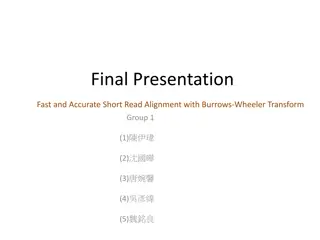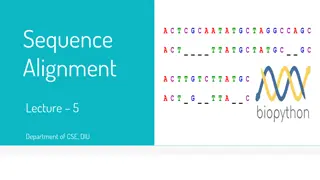Alignment and Rejection in Parent-Child Relationships
Children resisting contact with a parent post-separation may be due to parental alignment and rejection. This presentation delves into the complexities of this issue, exploring factors influencing children's behaviors, differentiation between alienation and estrangement, and the dynamics at play. The content discusses the history of Parental Alienation Syndrome (PAS), reformulation of parental alignment and rejection, and provides insights into therapeutic interventions.
Uploaded on Mar 03, 2025 | 2 Views
Download Presentation

Please find below an Image/Link to download the presentation.
The content on the website is provided AS IS for your information and personal use only. It may not be sold, licensed, or shared on other websites without obtaining consent from the author.If you encounter any issues during the download, it is possible that the publisher has removed the file from their server.
You are allowed to download the files provided on this website for personal or commercial use, subject to the condition that they are used lawfully. All files are the property of their respective owners.
The content on the website is provided AS IS for your information and personal use only. It may not be sold, licensed, or shared on other websites without obtaining consent from the author.
E N D
Presentation Transcript
MATH 2311 Help Using R-Studio
To download R-Studio Go to the following link: http://cran.cnr.berkeley.edu/ and https://www.rstudio.com/products/rstudio/download3/ Follow the instructions for your computer operating system.
Using Rstudio Packages Once you have installed Mosaic and Mosaic Data, click the checkboxes next to them, then .. command(filename$column) for example: mean(KidsFeet$length)
Basic Commands: Assign a data set to a variable: Type the following: assign( x ,c(2,3,4,5)) This will assign the list: 2, 3, 4, 5 to the variable x.
Basic Commands: Assign a data set to a variable (method 2) Type the following: x<-c(2,3,4,5) This will assign the list: 2, 3, 4, 5 to the variable x.
Calculating Mean, Median, and Standard Deviation Once a list is assigned to variable, you can easily calculate mean, median and standard deviation: mean(x) min(x) median(x) max(x) sort(x) sd(x) fivenum(x) Gives Min, Q1, Median, Q3, and Max length(x) How many elements
Try it out! Calculate the mean, median, and standard deviation of the following: 4, 6, 10, 11, 13, 15, 16, 20
Graphs in R-Studio Histograms: hist(x) Stem and Leaf: stem(x) Boxplots: boxplot(x) Pie Chart: pie(x) Dot Plot: dotchart(x)
Probability Distributions To enter a Random Variable: assign( x ,c(1,2,3,4,5)) assign( p ,c(0.5,0.3,0.1,0.05,0.05) Where p(1)=0.5, etc. For the mean: For the variance: sum((x-mean)^2*p) sum(x*p)
Binomial Distributions For an exact value: dbinom(x,n,p) For cumulative values: x=0,1,2, q pbinom(q,n,p)
Geometric Distributions For an exact value: dgeom(n-1,p) For cumulative values: x=0,1,2, q pgeom(n-1,p)
Hypergeometric Distribution For an exact value: dhyper(success, possible success, sample size, selection) For successes going from 0 through highsuccess: phyper(highsuccess, possible success, sample size, selection)
Normal Distributions: pnorm(z) will return the probability of obtaining less than a z-score of z. pnorm(x,mu,sigma) will return a probability of obtaining less than x with a mean of mu and standard deviation of sigma (standardization is not required).
Inverse Normal Distributions qnorm(p) will return the z score associated with a given probability (left tail). qnorm(p,mu,sigma) will return the x-value associated with a given probability for a mean of mu and a standard deviation of sigma (left tail).
Creating Scatterplots Once you have assigned lists x and y for the explanatory and response variables: plot(x,y) To determine the correlation coefficient: cor(x,y) To determine the coefficient of determination: cor(x,y)^2
Regression Lines: LSRL After data is inputted as lists x and y View the scatterplot: plot(x,y) Define the LSRL: Name=lm(y~x) View information on LSRL: Name This will identify the slope and y-intercept which you must place into y=mx+b for the equation of the line. See the graph of LSRL with scatterplot: abline(Name)
Residuals: To calculate a Residual: <<Actual Value>> - (LSRL with x-value substituted) Residual Plots: Residual = <<Response List>> - (<<slope>>*<<Explanatory List>> + <<y- intercept>>) plot(<<Explanatory>>,Residual)
Residuals (Method 2) After assigning the LSRL to a name, we ll use RegLine. Res=residuals(RegLine) Res plot(<Explanatory Variable>,Res)
Non-Linear Regressions: If the Response List is defined as y and the Explanatory List is defined as x For a Quadratic Regression: sqrtY=sqrt(y) plot(x,sqrtY) For Logarithmic Regression: expY=exp(y) plot(x,expY) For Exponential Regression: logY=log(Y) plot(x,logY)
Calculating the z* value: Use qnorm(1.##/2) For example, for a confidence interval of 95%, z* = qnorm(1.95/2)
Calculating a t* value: Use qt(1.##/2,df) For example, for a confidence interval of 95% with 12 degrees of freedom: qt(1.95/2,12)
Calculating a p-value (Decision-Making) If you are using a z-test: Left Rejection Region: pnorm(z-value) Right Rejection Region: 1-pnorm(z-value) Two-sides Rejection Region: 2*pnorm(z-value) {z must be negative} If you are using a t-test: Left Rejection Region: pt(t-value,df) Right Rejection Region: 1-p (t-value,df) Two-sides Rejection Region: 2*pt(t-value,df) {t must be negative}
Chi Squared Tests: assign( observed ,c(list)) assign( expected ,c(list)) This is probability * total value (observed-expected)^2/expected sum((observed-expected)^2/expected) 1-pchisq(previous line, df) df=categories 1























